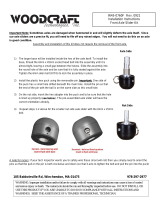
T2® / T2-HP
TM
/ T3 HD
TM
7
This symbol points out important safety
instructions which, if not followed, could en-
danger the personal safety and/or property of
yourself and others. Read and follow all instruc-
tions in this manual before attempting mainte-
nance on your transaxle. When you see this
symbol - HEED ITS WARNING.
WARNING
POTENTIAL FOR SERIOUS INJURY
Inattention to proper safety, operation, or
maintenance procedures could result in
personal injury, or damage to the equip-
ment. Before servicing or repairing the
T2
®
, T2-HP
TM
or T3 HD
TM
transaxle, fully
read and understand the safety precau-
tions described in this section.
PERSONAL SAFETY
Certain safety precautions must be observed
while servicing or repairing the T2, T2-HP or
T3 HD. This section addresses some of these
precautions but must not be considered an all-
inclusive source on safety information. This
section is to be used in conjunction with all
other safety material which may apply, such as:
1. Other manuals pertaining to this machine,
2. Local and shop safety rules and codes,
3. Governmental safety laws and regula-
tions.
Be sure that you know and understand the
equipment and the hazards associated with it.
Do not place speed above safety.
Notify your supervisor whenever you feel there
is any hazard involving the equipment or the
performance of your job.
Never allow untrained or unauthorized person-
nel to service or repair the equipment.
Wear appropriate clothing. Loose or hanging
clothing or jewelry can be hazardous. Use the
appropriate safety equipment, such as eye
and hearing protection, and safety-toe and
slip-proof shoes.
Never use compressed air to clean debris from
yourself or your clothing.
TOOL SAFETY
Use the proper tools and equipment for the
task.
Inspect each tool before use and replace any
tool that may be damaged or defective.
WORK AREA SAFETY
Keep the work area neat and orderly. Be sure
it is well lit, that extra tools are put away, trash
and refuse are in the proper containers, and dirt
or debris have been removed from the working
areas of the machine.
The oor should be clean and dry, and all ex-
tension cords or similar trip hazards should be
removed.
SERVICING SAFETY
Certain procedures may require the vehicle to
be disabled in order to prevent possible injury
to the servicing technician and/or bystanders.
The loss of hydrostatic drive line power may
result in the loss of hydrostatic braking capa-
bility.
Some cleaning solvents are ammable. Use
only approved cleaning materials. Do not use
explosive or ammable liquids to clean the
equipment.
To avoid possible re, do not use cleaning
solvents in an area where a source of ignition
may be present.
Discard used cleaning material in the appropri-
ate containers.
SAFETY





















